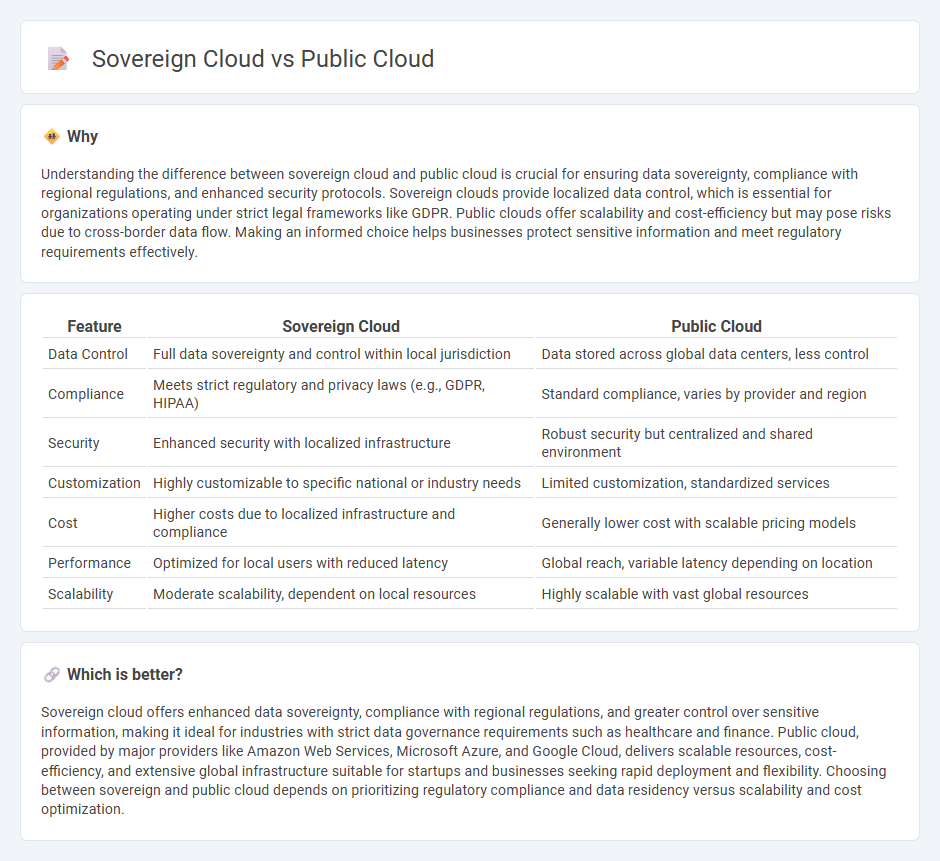
Sovereign clouds offer enhanced data sovereignty and compliance by storing information within specific legal jurisdictions, ensuring greater control over sensitive data compared to public clouds, which provide scalable, cost-effective resources shared among multiple users globally. Public clouds prioritize accessibility and flexibility, making them ideal for general workloads, while sovereign clouds cater to organizations with strict regulatory requirements. Discover how choosing between sovereign and public cloud impacts your business's data strategy and risk management.
Why it is important
Understanding the difference between sovereign cloud and public cloud is crucial for ensuring data sovereignty, compliance with regional regulations, and enhanced security protocols. Sovereign clouds provide localized data control, which is essential for organizations operating under strict legal frameworks like GDPR. Public clouds offer scalability and cost-efficiency but may pose risks due to cross-border data flow. Making an informed choice helps businesses protect sensitive information and meet regulatory requirements effectively.
Comparison Table
| Feature | Sovereign Cloud | Public Cloud |
|---|---|---|
| Data Control | Full data sovereignty and control within local jurisdiction | Data stored across global data centers, less control |
| Compliance | Meets strict regulatory and privacy laws (e.g., GDPR, HIPAA) | Standard compliance, varies by provider and region |
| Security | Enhanced security with localized infrastructure | Robust security but centralized and shared environment |
| Customization | Highly customizable to specific national or industry needs | Limited customization, standardized services |
| Cost | Higher costs due to localized infrastructure and compliance | Generally lower cost with scalable pricing models |
| Performance | Optimized for local users with reduced latency | Global reach, variable latency depending on location |
| Scalability | Moderate scalability, dependent on local resources | Highly scalable with vast global resources |
Which is better?
Sovereign cloud offers enhanced data sovereignty, compliance with regional regulations, and greater control over sensitive information, making it ideal for industries with strict data governance requirements such as healthcare and finance. Public cloud, provided by major providers like Amazon Web Services, Microsoft Azure, and Google Cloud, delivers scalable resources, cost-efficiency, and extensive global infrastructure suitable for startups and businesses seeking rapid deployment and flexibility. Choosing between sovereign and public cloud depends on prioritizing regulatory compliance and data residency versus scalability and cost optimization.
Connection
Sovereign cloud and public cloud are interconnected through hybrid cloud architectures that enable organizations to leverage the scalability of public cloud services while maintaining data sovereignty and compliance with regional regulations. Sovereign clouds provide localized, secure environments specifically designed to adhere to legal and regulatory requirements, which can integrate seamlessly with public cloud platforms for extended computing resources. This connection allows businesses to optimize workload distribution and data management while ensuring control over sensitive information within their jurisdiction.
Key Terms
Data Residency
Public cloud offers scalable, cost-effective infrastructure but often stores data across global data centers, raising concerns about data residency and regulatory compliance. Sovereign cloud ensures data remains within specific geographic or jurisdictional boundaries, providing enhanced control over data residency to meet local laws and privacy requirements. Explore detailed comparisons to understand which cloud model best secures your data sovereignty needs.
Compliance
Public cloud providers offer scalable infrastructure but face challenges meeting specific data sovereignty and regulatory compliance requirements. Sovereign clouds prioritize strict adherence to regional data protection laws, ensuring data residency, encryption standards, and audit controls tailored to government or industry mandates. Explore detailed compliance frameworks and case studies to understand which cloud solution aligns best with your organization's regulatory obligations.
Multi-tenancy
Public cloud environments offer multi-tenancy by allowing multiple organizations to share the same infrastructure, optimizing resource utilization and reducing costs. Sovereign clouds, designed for data sovereignty and regulatory compliance, implement multi-tenancy with strict isolation measures to ensure data privacy and control within specific jurisdictions. Explore more about how multi-tenancy shapes cloud security and efficiency in different deployment models.
Source and External Links
What Is Public Cloud? | IBM - Public cloud is a type of cloud computing where a third-party provider delivers computing resources--including applications, virtual machines, and infrastructure--to users over the internet, with the provider managing hardware, maintenance, and security, and resources typically shared among multiple tenants in a multi-tenant environment.
What is Public Cloud? Definition and In-Depth Guide - Public cloud is a third-party managed, on-demand platform offering scalable IT resources, applications, and services via the internet, characterized by self-service provisioning, broad network access, multi-tenancy, rapid elasticity, and pay-per-use pricing, with responsibility for infrastructure and services handled by the provider.
What Is a Public Cloud? - Public cloud is a computing model in which third-party providers offer shared infrastructure and services--such as storage, computing, and applications--to organizations and individuals over the internet, providing scalability and flexibility while contrasting with private, hybrid, or multicloud approaches.
 dowidth.com
dowidth.com